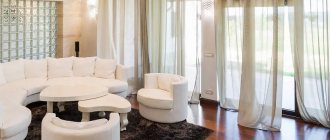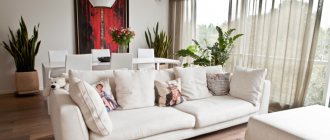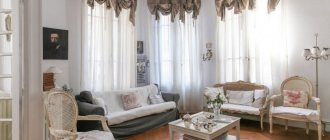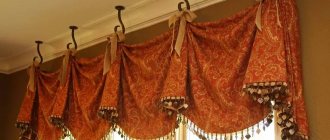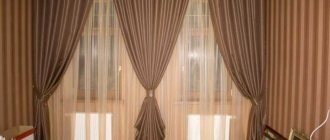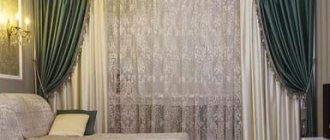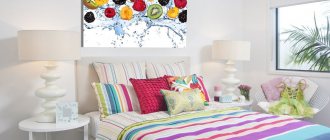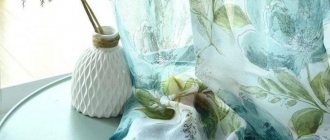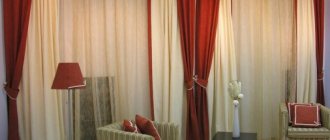The living room is usually the largest room in a house or apartment. The whole family spends a lot of time here and welcomes guests, so the decoration of the room must be impeccable. Curtains play a significant role in this. Thick, heavy fabric or thin tulle curtains not only decorate the room, making it unique, but also protect residents from prying prying eyes through the window.
Tulle in the hall will never lose its relevance in modern design.
Tulle, brief description, varieties, ideas for the hall
Tulle is a transparent, translucent fabric similar to a mesh. It is made using special curtain machines and painted in almost any color. You can select a product to match almost any existing interior, if it has at least some curtains.
You can radically change the overall look of your living room with the help of the right fabric.
Modern types of tulle in appearance are:
- transparent;
- matte;
- thread-like;
- in the net;
- with lace;
- decorated with embroidery.
An original way to decorate a small space.
Fabrics used:
- muslin;
- veil;
- muslin;
- net;
- batiste;
- tulle;
- jacquard;
- chiffon;
- organza.
They filter light especially beautifully and do not overload the space in the hall.
The photo also shows different ways of attaching tulle to the hall:
- on hinges;
- on eyelets;
- using braid.
Can be combined with any interior design.
Transparent curtains vary in length and location. In the spacious combined spaces of kitchens-living rooms, bedrooms-halls, studio apartments, the finest drapery, suspended on a cornice hidden in the stretch ceiling, can become an original zoning element that plays a purely symbolic role. You can hang such textiles both on windows, combining them with each other, and on a wooden, plastic, metal door, or arched opening. In the latter case, a “scattering” thread product is optimal.
Such curtains in the hall look much more interesting and original than ordinary ones.
Advice. The use of tulle curtains of one type or another, color, depends on the size of the space being designed and its stylistic design.
Which cornice do you prefer?
An important element of window design is the type of curtain fastening. However, the choice of cornice depends on the style of the interior.
- For the classics, baguettes and round rods are suitable, on which the curtains are strung using eyelets.
- For avant-garde interiors, it is better to choose thin strings or a flexible aluminum profile.
- Multi-row Japanese curtains require the use of rail or rail curtain rods.
The curtains can be mounted on the ceiling or on the wall. The choice depends on the height of the ceiling.
Forged cornices
Important! The weight of the curtains must be taken into account. If tulle is combined with heavy velvet hailstones, then it is better to choose durable metal or wooden rod curtain rods.
Varieties for the hall
The appropriate tulle for the room is selected based on the personal preferences of the owners of the room. This is a single-layer, two-layer drapery that covers a single window or covers two or three at the same time. When the windows are located on several walls at the same time (for example, as is the case with a bay window), it makes sense to decorate them from the same type of fabric. The length of the curtains is made to the floor, less often - to the window sill or the middle of the wall under it.
The bottom edge does not have to be even - products that are shortened in the middle and have angular, wavy cutouts look good.
Color is an important factor when decorating rooms. Usually these are white, beige, black colors, but interiors in the style of Art Nouveau, pop art, and futurism allow the presence of acid green, neon blue, and bright yellow options. The now very popular option of gradient coloring (that is, a smooth transition from a darker to the lightest tone) is embodied in different ways - traditionally it is “white top - black bottom”, but the arrangement is from right to left, diagonally, in the form of narrow stripes, rainbow multicolor also acceptable.
The most popular option is long, it looks elegant, visually enlarges the ceiling and the living room space as a whole.
The most commonly used solid colors are:
- snow-white;
- apple;
- white-pink;
- creamy beige;
- olive;
- pale blue;
- peach;
- blue-black;
- chocolate milk;
- champagne;
- light green;
- golden yellow;
- lilac.
It is the window decor that is considered the final chord in the room when it is decorated.
Advice. When the living room is decorated in a classic, neoclassical style, light tulle curtains are decorated with a golden border, rare embroidered details, ties, and tassels.
Tulle and curtains - how to combine correctly: options for a room without curtains
Typically, tulle and curtains in a classic design style, which consists of simple lines and light colors, are chosen for the hall. Baroque or Rococo styles are also still popular - ostentatious luxury: multi-layer curtains of various textures, draperies, a lot of lace, embroidery with gold threads.
But for modern houses and apartments, tulle and curtains are increasingly being chosen, adhering to the minimalist or hi-tech style.
If the curtains are bright and colorful, then it is better to choose a plain tulle or with a small, muted pattern. And if you hang the tulle fabric over the curtains, you will get a very beautiful and original imitation of translucency. Tulle without curtains in the living room will look very impressive, and in order to protect your personal space, you can use blinds.
Window decoration with tulle without curtains - description, examples, photos
Various tulle options for a room without curtains are also quite acceptable. A short drapery, just reaching the plane of the window sill, is optimal for horizontal or niche windows, as well as cramped rooms where every centimeter of free space counts.
Such a curtain looks most successful if there is no heating radiator below.
An even, mostly light, monochromatic floor-length curtain is optimally suited to the minimalist style. The second most popular option is a design of four transparent curtains, where one simply covers the entire wall with a window, the second is laid in the form of an inverted dome, and two more are approximately the same, but are shifted to the corners of the room.
The main thing is not to make a mistake and choose curtains that will match the overall style and give the living room a finished look.
The advantages of a design consisting only of tulle draperies:
- there is no need for a heavy cornice - even a “string” will withstand the tulle;
- such products are easy to wash, most of them do not need ironing;
- the room quickly transforms without becoming darker or cramped.
Luxury in a great room will never go out of style.
A two-row product with eyelet rings matched to the tone of the curtains looks great here. Thin muslin or so-called “thread curtains” often have several layers, and the window is decorated with two or three colors at the same time. For very large windows, luxurious products with photo printing or images applied using the batik technique are suitable. Typically, a colorful picture is not applied completely to the entire fabric, but only frames the rectangle of the window, becoming a unique accent of the room.
Similar options are offered by many “copy centers” specializing in large-format printing on fabrics to order, as well as art workshops.
Advice. If tulle textiles are decorated with a bright picture, it is undesirable to lay it in the form of many textured folds - the image will become difficult to distinguish and lose its attractiveness.
Care Tips
Tulle, like any other fabric, needs special care. First of all, it is necessary to take into account the material of manufacture. If you buy a finished product, always pay attention to the manufacturer's advice. Let us describe several rules that are suitable for caring for standard tulle:
- If a stain has formed on the surface, it must be removed before washing, depending on the type of fabric;
- It is better to first shake the product and soak it briefly in a soap solution or with the addition of a powder suitable for the type of fabric;
- Hand washing is recommended, but since the volume of the product may be too large, machine washing on a delicate cycle is possible;
- The washing temperature should not exceed 40 degrees;
- To wash tulle, it is preferable to use liquid detergents, and when rinsing, add conditioner;
- When hand washing, do not twist the items. and when using a machine, set the spin speed to low;
- After washing, it is best to hang the curtains back in a slightly damp state. This will save time on ironing;
- If ironing of the product is necessary and permitted, it is best to carry it out through cotton cloth (or gauze) at a minimum temperature;
- It is not recommended to dry tulle in direct sunlight. This may cause the base color of the product to yellow or fade.
Choosing tulle for the living room is a responsible task. To choose the right one, you need to take into account a large number of factors. However, the result is an ideal place to relax and meet guests. Curtains will certainly add comfort and special charm to any room!
© 2022 textiletrend.ru
Tulle plus curtains
Thick curtains combined with tulle are the most popular option at all times, as evidenced by numerous photographs on the pages of glossy design magazines. Velor curtains together with crepe-weave tulle create a changeable picture - their color and texture change depending on the level of illumination and the angle of incidence of the light. Tulle, like curtains, is decorated with lambrequins, which are a narrow strip of fabric running along the very top of the product or a luxurious design made of voluminous flowers, using textured ruffles and flounces.
It is in this style of decoration that a curtain made of thin and plain fabric will come in handy.
It is important to choose the right tulle and curtains for the decor in a particular room - if the furniture is dark, light draperies are recommended; when the wallpaper is patterned, the curtains should be plain. Variegated floral patterns on curtains are acceptable for a rustic style, checkered or houndstooth for country, and intricate weaves in dark colors for Gothic.
The tulle flowing from the ceiling should also be combined with the overall theme of the room and be functional and practical.
Choosing a cornice
Before hanging the tulle on the window, you need to choose a cornice.
The determining factor is the textile composition:
- Tulle without curtains. In this case, a string or rod cornice is used. The first option is a steel wire stretched between the brackets. It is suitable for light and thin products. The design is simple and durable. Over time, the metal succumbs to corrosion. A rod cornice is a metal or plastic pipe with rings.
- Tulle and curtains. You can hang them on a rod, baguette or profile cornice. The first option is classic, corner, arched, sliding. Profile (rail) - flat products with tracks inside. Its design often includes a rotating mechanism.
- Tulle on lambrequins. For such compositions, a triple modified profile cornice is used.
For expensive interiors, designer cornices are used.
Tulle drapes
Heavy curtains are also easy to combine with tulle. The word “curtains” literally means “door”, that is, a product that protects against the entry of strangers, but at the same time is capable of closing and opening.
Previously, doorways were often curtained with them, but in modern times this item is placed mainly on windows.
Curtains are often equipped with tiebacks made of various materials; two such curtains are made or just one. Thick fabrics are usually made darker than the tulle itself, but there are exceptions. Multi-colored curtains are selected for a simple plain tulle fabric, while more strict, restrained options are used for patterned fabrics decorated with knots, ruffles, and embroidery.
A voile tulle would be an excellent solution for a hall of this style.
Things to consider
Before choosing curtains and tulle for the hall, you need to understand what function the window decoration will perform. The room itself and its characteristics are also of great importance.
What needs to be determined:
- curtains are used as a decorative element or carry a functional load;
- window and room size;
- location in relation to the cardinal directions, therefore, illumination;
- interior style;
- practicality and ease of use.
Based on these points, curtains for the windows are selected.
Tulle with patterns - description, examples
Tulle in a room is often decorated in abundance with intricate patterns, including multi-colored ones - it looks incredibly beautiful, luxurious, and expensive, especially if the fabric chosen is shiny. The main design options are flowers, leaves with twigs, silhouettes of birds, butterflies, abstractions. Less common are full-fledged plot paintings - usually these are one-piece products, made by hand or to order.
There are ample opportunities for visual creativity here, limited only by the imagination of the author or customer.
The product with knots and voluminous embroidery has an interesting texture. Depending on the number of colors used, they decorate a room in a baroque, rustic, art deco or African interior.
When choosing a color, you can act boldly and creatively or give preference to more proven tones and shades.
Feature of black color
All textiles have one very important feature - they absorb most of the light entering the room, so it is very important to maintain a balance between the texture of the fabric and the area of the room.
The denser the fabric, the worse it transmits the sun's rays. This may be the reason for choosing not curtains, but black tulle. This way the space will not be visually reduced, but the color palette will be preserved.
For a small room, you can not drape the entire window, but only part of it with black tulle; in the interior, the airy fabric will create beautiful curves and folds.
In this case, the basic curtain can be of a contrasting color. This will be emphasized even more favorably by a bay window.
However, you should not combine black with gold ornaments. So the whole image of the room becomes heavy.
How to choose tulle: selection criteria, recommendations for housewives
The most beautiful tulle for a hall in a photo from the Internet does not always look luxurious and unique - a simple white drapery will perfectly decorate a small living room decorated in a rustic style. A product completely devoid of patterns is suitable for minimalism, and curtains replete with lambrequins are suitable for baroque and classics.
White color can fit into any interior. Visually expands the living room space, making the room airier and lighter.
When choosing, first of all, it is important to correctly determine the appropriate length. To do this, measure the height from floor to ceiling. Excessively long options, falling in folds to the floor, are suitable for baroque, renaissance, empire, shortened ones - for country, minimalism. For rooms decorated in a modern high-tech style, shiny fabrics with a silver tint, muslin consisting of metallized threads, or the usual white version, with a photograph of a big city, cars, or simple geometry, are suitable.
Tulle curtains will have a positive effect on the atmosphere in the living room, causing positive emotions and tranquility.
Dark materials are suitable only for spacious, well-lit rooms with high ceilings. For tighter spaces, light, transparent fabrics that do not block the penetration of daylight are recommended. When using several colors, it is important to choose one main one, which will take up to 60-70% of the space being designed, one secondary one - it will get no more than 35-30%, another color scheme - small color accents. It is not recommended to use more than three colors at the same time - the only exceptions are boho and pop art interiors.
How to properly care for tulle
Tulle is a thin and delicate fabric that requires careful handling. Washing should be done in a gentle mode at a temperature not exceeding 40 degrees.
It is necessary to rinse the fabric thoroughly so that the remaining powder, when exposed to sunlight, does not cause the formation of yellow spots. Chlorine-based bleaches can only be used on natural materials. Adding table salt to the washing water will help to achieve ideal cleanliness of synthetic tulle.
It is better not to iron tulle curtains. To get rid of creases, it is better not to wring out the tulle, but to let most of the water drain and hang it wet on the curtain rod.
This approach will keep the delicate fabric in good condition for a long time.
How to beautifully hang tulle in the hall
The most ordinary tulle in a room in various photos, not to mention the more original products sewn in the workshop, greatly decorates any room. To begin with, it is important to decide: will it be a single-layer version or a more complex design, how many colors are supposed to be used. If drapery is intended not only for windows, but also for doors, as a zoning detail, it is carefully selected by color - it is advisable to use the same color in all places in the room.
It is worth paying attention to the types of fastenings in order to properly hang curtains in the hall.
Options for hanging tulle depend on the design of the cornice:
- in the form of a pipe, a rod - rings with hooks and eyelets of the appropriate diameter are used here;
- from a metal profile - single-row or multi-row fastening, hanging with clips, hooks;
- string - thin, inconspicuous, consists of a metal, polymer string or several, easily holds one or three draperies.
Rings can be matched to the overall look of the room, combined with each other, and chosen in color and material.
You can sew an original tulle product yourself. To do this, you will need a sufficient amount of material, a sewing machine, threads, scissors, fasteners, patterns, as well as a clear idea of what should happen in the end. Often, braid or drawstring is used to hang tulle curtains; with your own hands, if you have the necessary equipment, eyelets are attached to the curtains - then they will become indistinguishable from factory ones. Colored ribbons, textile flowers, beads, metal tiebacks, etc. are suitable as decorations.
Manufacturing materials
Curtains must be chosen taking into account the size of the room, the height of the ceiling, and the shape of the window opening.
The following types of fabrics are used to make tulle:
| View | Characteristic |
| Veil | The material is durable, has a dense structure, and does not absorb dust. The fabric drapes easily and patterns look good on it. It creates a luxurious interior and is presented in a rich range of colors. The disadvantage of tulle is its inability to allow air to pass through well. The veil darkens the room, so you don’t need to use curtains |
| Organza | The material transmits light well. For production, polyester is used in combination with silk or viscose fibers. Organza washes and dries quickly, does not lose its shape, and does not accumulate dust. Such a curtain does not allow air to pass through well |
| Net | It is breathable and does not darken the room. Cells come in different sizes. This type of tulle in the living room is used in combination with curtains. Sometimes the mesh is decorated with laser thread, rhinestones, lace |
| Kiseya | This fabric is made of synthetic, cotton or silk threads hanging separately from each other. Kisey can be monochromatic or multi-colored. It is not able to completely replace tulle |
| Batiste | A synthetic material that holds its shape well, has a small thickness, and transmits light. It is better to combine cambric with curtains |
| Jacquard | Complex tulle made from threads of different colors and thicknesses. This makes the material multi-colored and embossed |
The most common is nylon tulle. There are also linen, silk, and cotton products.
What tulle is in fashion now?
One of the newest trends offered by designers is the placement of tulle over curtains. A short version of this drapery is now also considered very fashionable. New items in curtain stores this season are Roman blinds, made of the finest lace material. They look best in the style of Provence, Scandinavian, and classic interiors.
The brown color in the room goes well with natural wood furniture and brings significant solidity to the interior.
Fashionable now is a romantic interior style, decorated in “powdery”, pastel colors. Light silk fabrics, decorated with many tassels, combined with curtains supported by metal rings, are also popular. Linen openwork options are used mainly in ethnic, ecological interior styles - their coloring remains natural or the textiles are slightly tinted, including with smooth gradients.
Versatile and natural. Beige tulle will successfully hide all the imperfections of the windows and walls in the room.
Damask patterns combined with “rustic” textures are also trending, which will best decorate Scandinavian and modern interiors. Diamonds and “flies”, made both textured and contrasting, often decorate mesh draperies. Curtains embroidered with roses, tulips, and fantasy branches of heavenly flowers will not leave anyone indifferent.
Rules for using black
If you do not pursue a decorative purpose, it is best to choose a plain tulle. The combination with a spectacular curtain will slightly enlarge the room and add the necessary accents.
Black patterned tulle is more suitable for a spacious living room. It is important to choose the right shade of black so that the image of the room is uniform.
In this case, you can experiment with the texture of the fabric. Micro veil or organza looks great. A little glitter or embroidery is allowed.
Despite the fact that lace tulle was popular in the 80s, “granny” curtains are increasingly being found in the interiors of modern apartments.
Black and white tulle with contrasting embroidery looks great. Gray embroidery looks original in this color scheme.
Embroidery can have both geometric and floral patterns. Tulle with black flowers is suitable for a classic style. The ornament can be placed both vertically and horizontally. Straight lines elongate the plane.
The correct use of black textiles is emphasized by the presence of additional elements in the room. For example, if there are a lot of mirrors or mirrored facades of cabinet furniture in the room, black color will not make the room smaller.
Tulle in the living room in a modern style: photo
The material consists of thin fibers and is good at dispensing lighting.
On a note!
Modern tulle can have embroidery, drawings and photo printing, which gives additional scope for imagination.
In addition, there are different types of this material:
- veil;
- net;
- organza;
- nylon
For your information!
Designers like this fabric for its quality of workmanship, flexibility of structure and the ability to find the right option for any budget.
The latest catalogs of current interior trends are replete with all sorts of placement options, sewing tulle for the living room, kitchen, bedroom and even garden gazebos.
In modern living rooms, tulle takes on various geometric shapes. This is an opportunity to create limitless space, play with color and shades. Variations:
- Curves can flow from one corner of the wall to another, from the bottom edge to the top, creating an airy and open feeling. Too frequent and abrupt transitions are not encouraged - the principle of moderation must be observed.
- Straight lines make the interior simpler, uncluttered, without unnecessary details. There may be several lines. The presence of 3-5 stripes on the fabric is quite acceptable.
- The layering of the curtain creates the effect of depth and adds volume. It is important here not to add too much. A modern living room will easily accept up to 3 layers and shades.
- The predominance of light colors, because the main task is to bring more light and air into the living room.
On a note!
White, beige, golden and blue shades remain relevant. The tulle may contain synthetic fibers. They refract color well and shimmer in the light.
How to choose tulle for a nursery
Parents strive to arrange a space for their baby with maximum attention. Window decor occupies one of the main places among the elements that set the mood in the room in which your baby will spend most of his time.
When choosing tulle for a nursery, keep in mind that:
- the material must be of high quality and ensure environmental cleanliness and safety, and withstand repeated washing;
- short curtains will prevent the child from getting tangled during active games, and they also allow you to use the window sill as the brightest place in the room for drawing or placing toys;
- When choosing a picture, you should focus on the age and gender of the child, as well as his personal interests and preferences.
If it’s hard for you to choose one design, buy several different tulle curtains for your child’s room. This way you can regularly update your interior without much effort.
Tulle in a nursery can also be used to decorate a crib with a canopy or to zone the space, highlighting the sleeping and play areas of the room.
Beautiful tulle for the living room in 2022: interesting options
Additional designs and accessories in the form of brooches, swings, fringe, beads, etc. are no longer needed. The most interesting and easy-to-implement ideas:
- Linen tulle attached with eyelets. Suitable for a living room in a classic style. It transmits light perfectly. The light beige color gives the living room additional comfort and sophistication. Classic length - to the floor.
- Silky organza mid-window length with Roman mechanism. It wears a copper tone with golden flecks. Such a curtain can be gathered up and down, depending on how much light you need to let into the room.
- Roller shutters made of tulle with natural fibers and a printed pattern. They will bring a touch of mystery and fabulous unknown. The color scheme can be varied - from neutral white to all shades of orange. At sunset, the roller shutters are opened and the tulle reflects the fabric pattern on the walls.
- This technique of choosing tulle to match the color of the walls almost never loses its relevance. But it only works in a light palette. Dark colors will make the living room gloomy and visually take away the volume. The curtain should be located along the entire length of the wall, and the width can be selected according to the desire and taste of the owner.
- The tulle, divided into 2 parts, is placed on two stripes. The emphasis is on gradient colors. White gradually turns into gray and then into a graphite shade. The front layer is tied with a simple cord below the window sill level by 10 cm.
- Japanese curtains with oriental prints. Tulle is made from natural fibers of cotton, linen or silk. Several sheets of fabric are attached to a multi-strip cornice, weighted at the bottom with a small metal or wooden stick. This design makes the canvas perfectly straight and smooth. A pattern with an oriental theme adds extra exoticism to the interior, but does not overload it.
- Tulle mesh with a color that smoothly transitions from white to light gray. A good option for a modest budget. A simple design made of silver thread is embossed along the lower edge of the tulle. The edges do not reach the floor by 0.5-1 cm. The same option can be divided into 2 parts and gathered on the sides with a ribbon to match the mesh.
For your information!
In 2022, when choosing tulle for the living room, you should follow the principle of minimalism and simplicity of design.
Tulle in a modern style room still leaves room for imagination and material for window decoration. Erase the boundaries of space by removing curtains from the room and leaving airy tulle, giving it the opportunity to enliven the room, make it soaring and let in light. There is not a single design direction left where organza, veil or mesh cannot be used. These are materials from one group of tulle fabrics, which can be varied in composition, palette and pattern. According to experts, they will be relevant for more than one season.
Properties of tulle
The texture of tulle and the patterns on it can be different.
This type of material looks quite unusual and attracts attention, causing associations with the outfits of fairy princesses. However, in addition to purely external beauty, tulle has a number of practical positive qualities:
- lightness - the fabric does not require complex fastenings, there is no risk of breakage of the textile structure;
- transparent material allows a lot of light to pass through, helping to visually enlarge the room;
- the delicate texture of the tulle allows you to see everything that is happening outside, outside the window, and also hides the interior of the room from prying eyes;
- the fabric is easy to care for, it can be washed in a regular washing machine, although it does not require frequent water treatments;
- almost all types of tulle do not require ironing, the material dries very quickly;
- breathability - does not retain air at all, does not interfere with filling the room with oxygen and fresh air;
- smooth tulle with small cells also traps insects in the summer;
- wide choice of color, type, texture, texture, appearance and density;
- affordable price (there are simple, uncomplicated fabrics, as well as elite silk products, in a word, curtains can be sewn to suit every taste and budget).
The material has practically no disadvantages, however, due to its lightness and delicacy, it is recommended to protect tulle from mechanical damage. Snags and snags can appear if the canvas is constantly pulled, if children play near the window, and also if there are animals in the house.
Classic white tulle requires special attention and care. The slightest dirt is simply visible on this type of material, so the requirements for white products are high - tulle must be strong, wear-resistant in order to withstand frequent washing.
